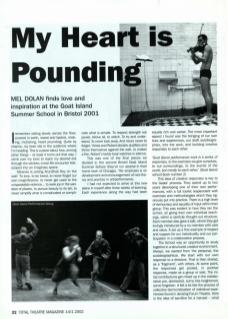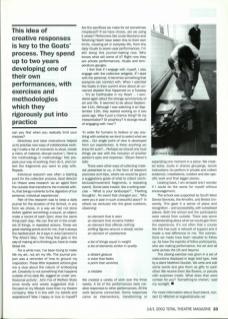I remember sliding slowly across the floor, covered in earth, sweat and lipstick, shaking, muttering, heart pounding. Quite by chance, my lover sits in the audience where I'm heading. This is a piece about love, among other things – at least it turns out that way. I climb over my lover to reach my desired exit through the window, a real-life encounter telescoped into an imaginary space.
Miranda is writing Arundhati Roy on the wall: ‘To love, to be loved, to never forget our own insignificance, to never get used to the unspeakable violence... to seek joy in the saddest of places, to pursue beauty to its lair, to never simplify what is complicated or complicate what is simple. To respect strength not power. Above all, to watch. To try and understand. To never look away. And never, never to forget.' Krista and Robert declare dualities and throw themselves against the wall. Jo makes a fire. Robert's teddy bear watches in silence.
This was one of the final pieces we devised in the second Bristol Goat Island Summer School (they've run several in their home town of Chicago). The emphasis is on development and encouragement of new theory and practice in art/performance.
I had not expected to arrive at this new place in myself after three weeks of learning. Each experience along the way had been equally rich and varied. The most important aspect I found was the bringing of our own lives and experiences, our draft autobiographies, into the work, and building creative responses to each other.
‘Goat Island performance work is a series of responses to the exercises we give ourselves, to our surroundings, to the events of the world, but mostly to each other.' (Goat Island school book number 2)
This idea of creative responses is key to the Goats' process. They spend up to two years developing one of their own performances, with a full toolkit resplendent with exercises and methodologies which they rigorously put into practice. There is a high level of democracy and equality of input within their group. This was evident in how they ran the school, all giving their own individual teachings, within a carefully thought-out structure. Each member also gave a talk, where they got lovingly introduced by a co-member with care and value. It set up a fine example of respect and support for our individuality and our participation in a collaborative process.
The School was an opportunity to study together in a structured creative environment. Always, we started from the personal, the autobiographical. We start with our own response to a directive. That is then shared, as a ‘fragment', with others. At some point, the responses get pooled, in another response, made as a group or solo. The initial contributions get mixed up in the collaborative pot, abstracted, some bits heightened, some forgotten. It felt a lot like the process of collective democratisation of individual experiences found in devising Forum Theatre. Here is the idea of sacrifice for a harvest – what can you find when you radically limit your choices?
Directives and clear instructions helped us to practice new ways of collaborative working ('make a list of moments to steal, create a menu of material, disrupt routine'). Here is the methodology in methodology: first prepare your way of working, then do it, and collect the fragments you want to play with. Repeat.
Individual research was often a starting point for the collection process. Goat director Lin Hixson sees research 'as an agent from the outside that transforms the material within, that brings nutrients to the digestion of our personal, individual experiences'.
Part of this research was to keep a daily journal for the duration of the School, in any form we chose, in a way we had not done before (gather something: a sound, an object; make a record of each 2pm; draw the same thing each day). We can find art in the smallest of things, in repeated actions. These are great starting points and for me, that's always the hardest part. As it says in Julia Cameron's The Artist's Way, the thing that gets in the way of making art is thinking you have to make Great Art.
For a while now, I've been trying to make life my art, not art my life. The journal project was a reminder of how to ground my inspiration. These little repeated actions give me a clue about the nature of embodying art. Creativity is not something that happens outside of my daily life, tagged on under 'professional activity'. John Fox of Welfare State once kindly and wisely suggested that I focused on my lifestyle more than my theatre company. Was it in line with my beliefs and aspirations? Was I happy or true to myself?
Are the sacrifices we make for art sometimes misplaced? If we have choice, are we using it wisely? Performers like Linda Montano and Tehching Hsieh have taken this to their own limits, creating art in everyday life, from tiny daily rituals to seven-year performances. I'm still doing this journal-making now. Who knows what will come of it? Right now they are private performances, rituals and temperature-gauges.
I feel that if I engage with myself, I also engage with the collective zeitgeist. If I start with the personal, it becomes something that everyone can connect with. When I watched the Goats in their current show about an unnamed disaster that happened on a Tuesday – It's an Earthquake in my Heart – I wondered again about the strange synchronicity of art and life. It seemed to be about September 11th. Although I was watching it on September 12th, they started working on it two years ago. Was it just a chance thing? Or my interpretation? Or prophecy? A strange result of engaging with 'now’?
'In order for humans to believe or say anything with certainty we tend to select what we view... Our single point of view is developed from our experiences. Is there anything we know for sure?... Perhaps we should only trust things we see with the inclusion of another person's eyes and response.' (Bryan Saner's talk)
There were other ways of collecting material presented to us, in the form of research exercises and trips, where we would be given a suggestions guide of what to collect (architectural/movement fragments, a repeating event). Some were inward, like a writing exercise – ‘What is your landscape?', 'Fleeting thoughts', 'An event that changed you', 'Why were you in pain in such a beautiful place?'. In others we ventured into the great outdoors, observing:
an element that is seen
an element that remains hidden
an element that offends nothing
shifting figures around a steady centre
an element of uselessness
a list of things equal in weight
a list of elements similar in quality
a distant gesture
a voice that fades
a point that vanishes
a mistake
We created a variety of work over the three weeks. A lot of the performances were creative responses to other performances. All the work became connected. Some responses came as interventions, transforming or expanding one moment in a piece. We created solos, duets in chance groupings, secret instructions (to perform in private and collect evidence), installations, outdoor and site-specific work and final bigger pieces.
Looking back, I am amazed and I wonder if I could do the same for myself without encouragement.
The school was supported by South West Dance Services, the Arnolfini, and Bristol University. This gave it a sense of place and recognition – and accessibility, with subsidised places. Both the school and the participants were valued from outside. There was some understanding about what we would gain from the experience. It's not often that a course like this has such a network of support and it made a real difference to me. The connections we made have been valuable to follow up. As have the exploits of fellow participants, who are making performance, live art and all sorts across the UK and beyond.
The closing exercise was given in a set of instructions displayed in large bold type, held by a silent Matthew Goulish. We write and edit some words and give them as gifts to each other. We receive them like flowers, or parcels with surprises inside. What does that word contain for you? 'Something to cherish,' said my word-gift.


